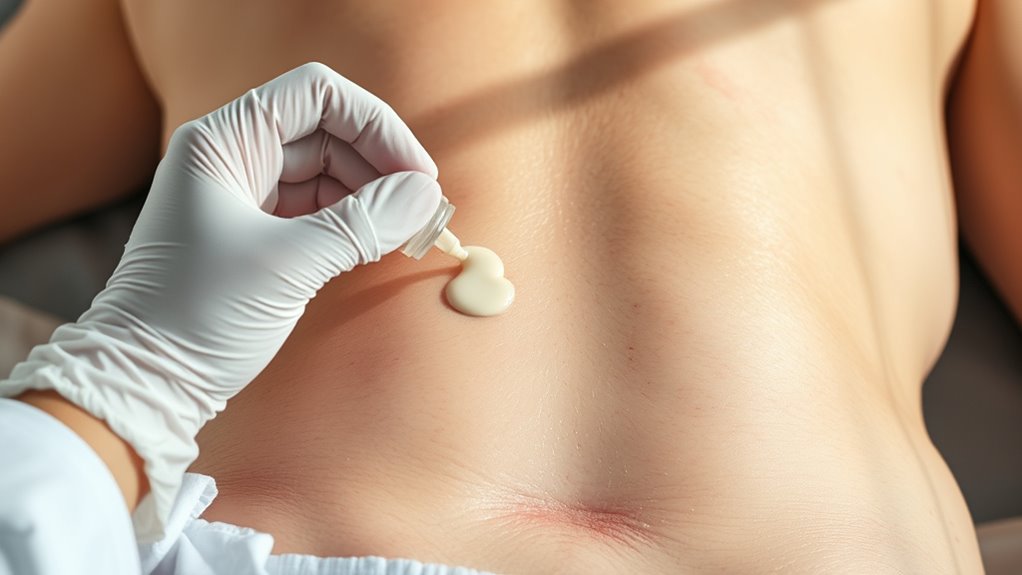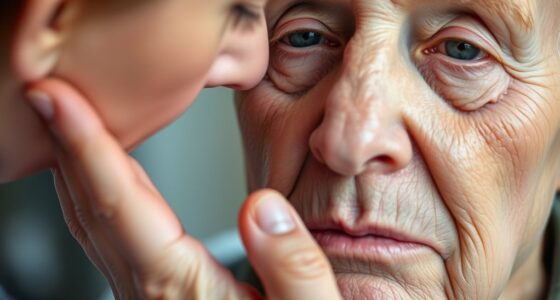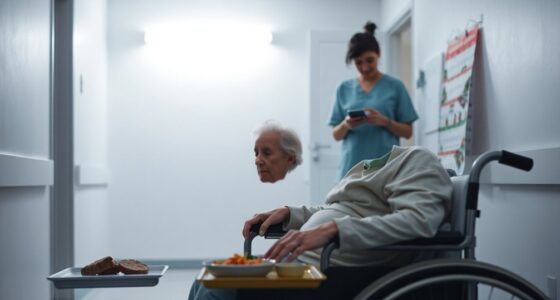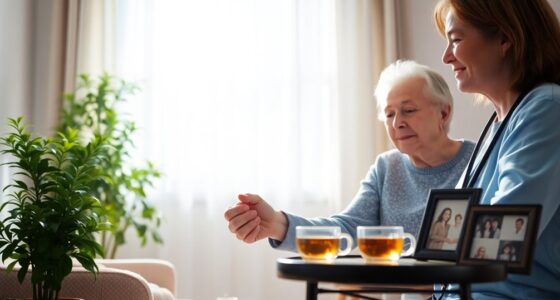To prevent bedsores in bedridden seniors, you should regularly reposition them every two hours to reduce pressure on vulnerable areas like heels and hips. Keep their skin clean and dry using gentle cleansing and barrier creams to protect against moisture damage. Inspect their skin frequently for early signs of redness or swelling, and support their skin’s resilience with proper moisturization. Continuing with these techniques helps maintain skin health and comfort, so learn more to guarantee effective care.
Key Takeaways
- Reposition bedridden seniors at least every two hours to relieve pressure on vulnerable skin areas.
- Keep skin clean and dry using gentle, pH-balanced cleansers and pat dry to prevent moisture buildup.
- Use barrier creams or moisturizers to protect skin from irritation and maintain optimal hydration.
- Regularly inspect skin for early signs of redness, swelling, or discoloration for prompt intervention.
- Maintain a consistent routine of repositioning, hygiene, and moisture management to promote skin health and prevent sores.
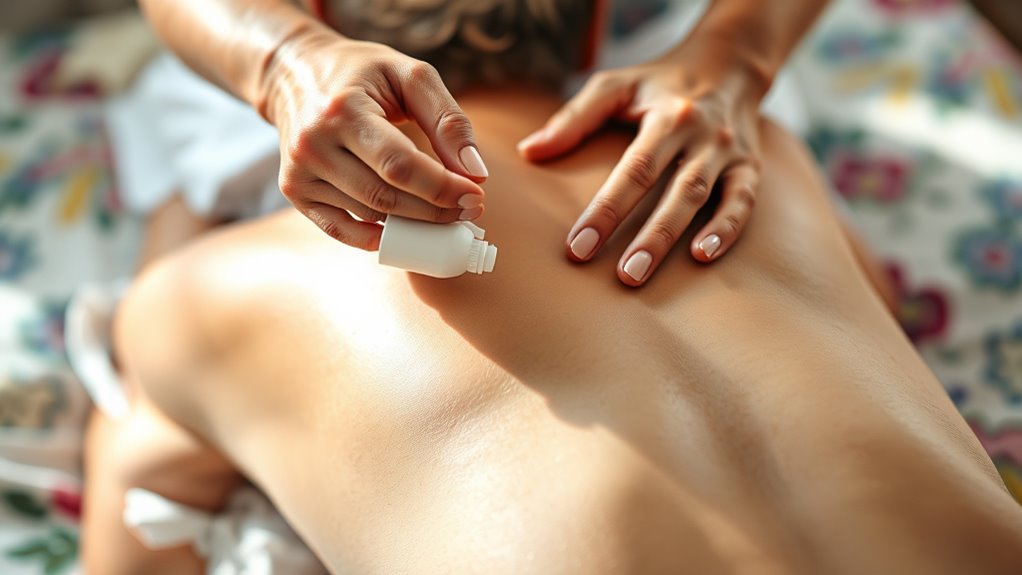
When seniors are bedridden, their skin becomes vulnerable to damage because they can’t shift position regularly. This lack of movement puts pressure on certain areas of the body, known as pressure points, which are especially at risk for developing sores. To prevent this, you need to pay close attention to these areas, such as the heels, sacrum, elbows, and hips, ensuring they’re relieved of pressure as often as possible. Regularly changing the senior’s position, at least every two hours, can considerably reduce the risk of pressure buildup. Using cushions or specialized mattresses can also help distribute weight more evenly, alleviating constant pressure on these sensitive zones.
Moisture management is equally essential in skin care for bedridden seniors. When skin remains damp from sweat, urine, or other bodily fluids, it becomes more prone to breakdown. You should keep the skin clean and dry, gently cleansing pressure points with mild, pH-balanced cleansers. After cleaning, pat the area dry carefully—rubbing can cause irritation—and apply barrier creams or moisturizers to protect the skin. These products create a protective layer that helps lock in moisture and shield against irritants. Avoid harsh soaps or alcohol-based products, which can strip natural oils and dry out the skin further. Proper moisture management supports the skin’s integrity, making it resilient against breakdown and infection. Incorporating preventive measures, such as regular skin assessments, can further reduce the risk of pressure ulcers. Understanding pressure points and their significance can help caregivers develop more effective repositioning routines. Regular skin checks and early interventions are critical components of comprehensive pressure ulcer prevention.
In addition to repositioning and moisture control, inspecting the skin regularly is indispensable. You should look for early signs of redness, swelling, or discoloration—indicators that pressure points are under stress. Addressing these signs promptly can prevent the development of full-blown sores. Incorporating gentle massage around pressure points to stimulate blood flow can be beneficial, but avoid massaging directly on areas that are already red or damaged. Maintaining good hygiene, changing bedding frequently, and ensuring the skin remains clean and dry are all part of an extensive approach to prevent skin deterioration. Recognizing early warning signs allows for quicker intervention and better outcomes.
Ultimately, caring for a bedridden senior’s skin requires vigilance and routine. By focusing on relieving pressure at key points and managing moisture effectively, you can considerably reduce the risk of bedsores. Your consistent efforts help maintain their comfort, prevent pain, and preserve skin health. It’s about creating a proactive routine that prioritizes skin protection, ensuring that even with limited mobility, their skin stays as healthy and intact as possible.
Frequently Asked Questions
How Often Should I Change a Bedridden Senior’S Position?
You should follow a consistent repositioning schedule, ideally changing a bedridden senior’s position every two hours. This helps prevent pressure buildup and encourages blood flow. Use pressure relief techniques like shifting weight gently or elevating certain areas to reduce pressure points. Regular repositioning and these techniques are essential for comfort and skin health, minimizing the risk of bedsores and ensuring your loved one stays comfortable and safe.
What Are the Signs of Early-Stage Bedsores?
Think of early-stage bedsores as warning signs on a map. You might notice skin discoloration, like a red or purple patch that doesn’t fade. Pressure ulcers often start with tender or firm areas that feel different to the touch. Keep an eye out for these signs, as they indicate skin is under stress. Catching them early helps prevent more serious damage and promotes healing.
Are Special Mattresses Effective in Preventing Bedsores?
Special mattresses are quite effective in preventing bedsores because they use advanced mattress technology that promotes pressure redistribution. By reducing constant pressure on vulnerable areas, these mattresses help improve blood flow and minimize tissue damage. When you choose a pressure redistribution mattress, you’re actively supporting your loved one’s skin health, making it a valuable tool in bed sore prevention. Always combine this with regular repositioning for the best results.
How Can I Keep the Skin Dry and Clean?
To keep the skin dry and clean, focus on moisture management and regular skin cleansing. You should gently pat the skin dry after washing, avoiding harsh scrubbing, and use absorbent pads or powders to reduce moisture buildup. Change bedding and clothing frequently to prevent dampness, and make certain of good hygiene. These steps help maintain healthy, dry skin and reduce the risk of irritation or infections, especially for bedridden seniors.
What Nutritional Supplements Support Skin Health?
You should consider adding nutritional supplements like Vitamin C and Zinc to support your skin health. Vitamin C helps boost collagen production, which keeps skin strong and resilient. Zinc plays a key role in skin regeneration and repair. Taking these supplements can enhance your skin’s ability to heal and resist damage, especially if your diet lacks these nutrients. Always consult a healthcare professional before starting new supplements to make certain they’re right for you.
Conclusion
Imagine your loved one’s skin as a delicate canvas, vulnerable to the silent threat of bedsores. By regularly turning them, keeping their skin clean and dry, and offering gentle care, you paint a shield of protection around them. Your attentive touch transforms their bed into a safe haven, preventing pain and discomfort. With each careful move, you nurture their comfort and dignity, ensuring they feel loved and secure even in their most vulnerable moments.
